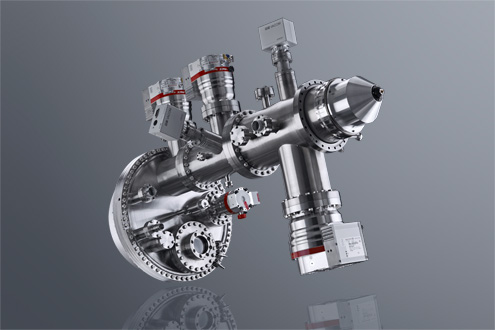Features:
- Wide Angle Pre-Lens with 44 ° Acceptance Angle
- Near Ambient Working Pressures up to 25 mbar
- Large Kinetic and Pass Energy Range
- High Energy and Angular Resolution
Applications:
- Surface Chemical Analysis in Elevated Pressures
- Catalysis Research
- XPS on Liquids
- Solid-Liquid Interface Studies
- Dynamics of Chemical Processes
- Electrochemistry
- Real-Time Monitoring of Chemical Process
Product Description:
The PHOIBOS 150 NAP Analyzer is a true 180° hemispherical energy analyzer with 150 mm mean radius. The analyzer, the lens system, and the detector are surrounded by two layers of 2 mm thick µ-metal to screen external magnetic fields down to an uncritical level. For ultimate performance, the analyzer and lens system are constructed entirely from non-magnetic materials inside the µ-metal shielding.
Electron Spectrometer Design
The transfer optics are a crucial part of the NAP electron spectrometer design. The first aperture, or nozzle, is shaped conically with a half angle of 35 °. This aperture, with a diameter of down to 0.3 mm, maximizes the differential pumping and brings the pressure down to the 10-3 mbar range a few millimeter, from the sample. This cone is detachable and can be exchanged by similar cones with different aperture diameters.
Behind the nozzle, a wide-angle deceleration lens using a focussing mesh with high transparency creates images of the sample region that is analyzed at the entrance aperture of the second lens stage with negligible spherical aberration. A quadrupole lens guides the beam to the entrance of a PHOIBOS 150 hemispherical analyzer connected to the focussing lens system.
Differential Pumping System
The PHOIBOS 150 NAP consists of a differentially pumped electrostatic pre-lens, with a three-stage differentially pumped PHOIBOS 150 analyzer. Thus, the design concept provides four separate pressure stages separated by apertures. The first pumping stage (prelens) is separated from the analytic chamber by a nozzle with an 0.3 mm hole at the tip. By using a turbopump with a pump speed of 500 l/s on the pre-lens stage, a pressure difference of four orders of magnitude (compared to the analytic chamber) is possible.
The first and second stages are separated by an aperture with a 4 mm diameter. A valve allows a high-vacuum seal between the stages. This second stage represents the first part of the electrostatic lenses of the PHOIBOS. The front and rear parts of the electrostatic lenses are separated by an iris aperture. The third pumping stage is situated behind the iris. The fourth and final pumping stage contains the hemispheres and detector.




